Lattice Extends Video Interface Platform to GigE/USB 3.0
Lattice Video Interface Platform GigE/USB 3.0
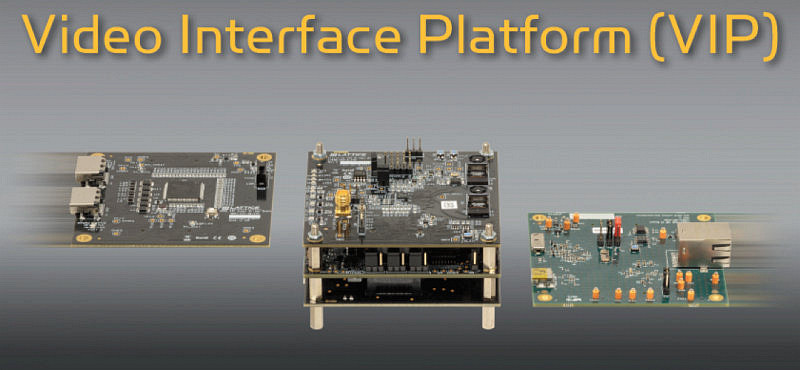
Need to quickly build embedded vision prototypes with Ethernet connectors running at Gigabit speeds?
Lattice’s latest I/O board for the Video Interface Platform (VIP) does just that. The new I/O board is the latest addition to Lattice’s highly modular platform.
By replacing cumbersome manual wiring with a unified connector, designers can quickly build plug-and-play solutions.
The new GigE/USB 3.0 I/O board allows developers to quickly and easily add network connectivity options to Lattice’s award-winning Embedded Vision Development Kit.

The kit combines a CrossLink mobile bridging input board, an optimised ECP5 image signal processing board, and high res HDMI VIP Input and Output boards into a ready-to-use platform.
The VIP platform also offers IP from 3rd party partners including commercial grade image signal processing and networking stacks, Helion Vision’s GigE Vision, multiple sensor board inputs, and DisplayPort IP from Bitec.
For more information on the Video Interface Platform from Lattice, please contact Allyanz today.
Ultra-Low Power Lattice sensAI Leads Mass Market Enablement of Artificial Intelligence in Edge Devices
New FPGA Solutions Open Doors for Rapid Deployment of Machine Learning Inferencing Across Broad Market IoT Applications Demanding Milliwatt Range Power Consumption
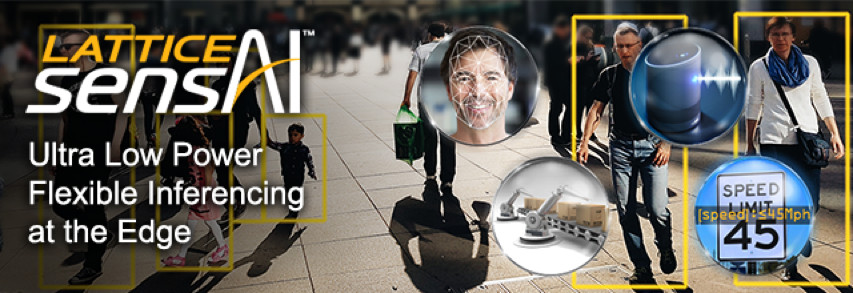
- Accelerates deployment of AI into fast growth consumer and industrial IoT applications including mobile, smart home, smart city, smart factory, and smart car products
- Optimized to provide ultra-low power (under 1 mW–1 W), small size, and production-priced (~$1-$10 USD) benefits of ASICs, with FPGA flexibility to support evolving algorithms, interfaces, and tailored performance
- Full-featured Lattice sensAI stack offers modular hardware platforms, neural network IP cores, software tools, reference designs, and custom solutions via partner eco-system
Lattice Semiconductor Corporation (NASDAQ: LSCC) has unveiled Lattice sensAI™ – a complete technology stack combining modular hardware kits, neural network IP cores, software tools, reference designs and custom design services – to accelerate integration of machine learning inferencing into broad market IoT applications.
With solutions optimized for ultra-low power consumption (under 1 mW–1 W), small package size (5.5 mm2 –100 mm2), interface flexibility (MIPI® CSI-2, LVDS, GigE, etc.), and high-volume pricing (~$1-$10 USD), Lattice sensAI stack fast-tracks implementation of edge computing close to the source of data.
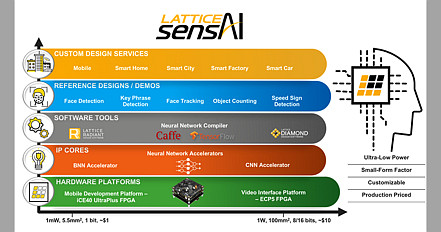
“Lattice sensAI addresses the unmet need for flexible, low cost, ultra-low power AI silicon solutions suited for rapid deployment across a wide range of emerging, mass market IoT applications,” said Deepak Boppana, senior director, product and segment marketing at Lattice Semiconductor.
“By delivering a full-featured machine learning inferencing technology stack combining flexible, ultra-low power FPGA hardware and software solutions, the Lattice sensAI stack accelerates integration of on-device sensor data processing and analytics in edge devices. These new edge computing solutions build on our leadership in FPGAs for edge connectivity, implementing flexible sensor interface bridging and data aggregation in high-volume IoT applications, including smart speakers, surveillance cameras, industrial robots and drones.”
To address the computing opportunities at the Edge, Lattice’s sensAI stack includes the following:
- Modular Hardware Platforms – ECP5™ device-based Video Interface Platform (VIP), including the award-winning Embedded Vision Development Kit, and iCE40 UltraPlus™device-based Mobile Development Platform (MDP).
- IP Cores – Convolutional Neural Network (CNN) accelerator and Binarized Neural Network (BNN) accelerator.
- Software Tools – Neural network compiler tool for Caffe/TensorFlow to FPGA, Lattice Radiant™ design software, Lattice Diamond® design software.
- Reference Designs – Face detection, key phrase detection, object counting, face tracking, and speed sign detection.
- Design Services – Eco-system of design service partners delivers custom solutions for broad market applications, including smart home, smart city, and smart factory.
Please contact Allyanz today for further details on Lattice sensAI™, including samples & evaluation boards.
ISSI Announces Full Function LED Driver IC For Automotive Interior Lighting
ISSI Full Function LED Driver IC For Automotive Interior Lighting
150mA Linear LED Driver with Push-Button Input Combined with Courtesy Signal
Integrated Silicon Solution, Inc. (ISSI), a leader in advanced memory and analog IC solutions, has announced a single chip solution for automotive interior lighting.
The IS32LT3175 is a feature-rich AEC-Q100 certified linear LED driver enabling reduced BOM count for low-cost and compact designs.
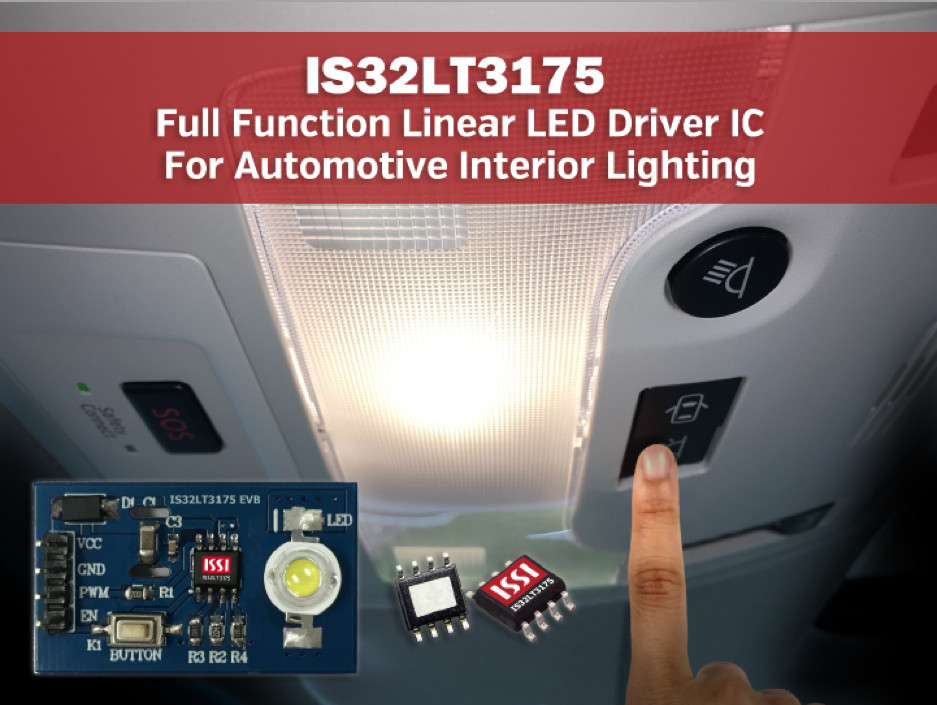
Key features and benefits of the IS32LT3175 include:
- Reduced BOM: LED driver with theatrical dimming in one small 8 pin SOP package resulting in 65% less components requiring less printed circuit board area.
- Linear LED Driver: Low-noise, low-EMI, linear current source adjustable from 10~150 mA into one or more LEDs.
- Switch Input: Integrates switch debounce and latching logic to enable use of low cost momentary contact switch. The switch On/Off state is held during start-stop operation when voltage drops below 6V for a short period of time.
- Local or Remote: Can be controlled remotely by the automobile’s microcontroller or locally with a momentary contact switch. The local switch has priority over the remote microcontroller providing the user with direct control of the LED lamp.
- No Microcontroller: Advanced LED performance can be adjusted with simple resistors, eliminating the need for a microcontroller.
- AEC-Q100: Meets stress testing specifications making it suitable for use in the harsh automotive environment with guaranteed operation from –40°C to +125°C.
Please contact Allyanz today for further details and support on ISSI’s range of LED drivers, including samples & evaluation boards.
ISSI Launches Next Generation Family of Matrix FxLED Driver ICs
IS31FL3741, IS31FL3742 drive up to 351 LEDs and support individual LED lighting effect functions for creating a configurable array of color animation visuals with fault reporting
Integrated Silicon Solution, Inc. (ISSI), a leader in advanced memory and analog IC solutions, has announced a family of high performance LED drivers, IS31FL3741 & IS31FL3742 to support LED matrices consisting of 351 & 180 LEDs respectively.
With the introduction of these two devices, ISSI expands its FxLED driver family to offer the widest selection of matrix LED driver solutions for gaming, consumer and white goods applications.
ISSI’s LED matrix architecture provides designers with flexibility in controlling individual LEDs or an array of LEDs resulting in simplified color & dimming adjustment and lighting zone selection for a large array of LEDs.
The IS31FL374x family of matrix LED drivers integrates many advanced features such as a configurable matrix (row/column) architecture, global dimming, individual LED peak current control registers, individual LED PWM control registers, individual LED open/short fault detection; all accessible via a fast 1MHz I2C compatible bus interface.
Each LED has its own corresponding control and fault status register to provide individual LED color and dimming effects, de-ghosting and fault reporting for enhanced overall system performance and reliability.
LED matrix architectures typically experience a “ghosting effect” where an LED remains dimly ON due to a residual charge in the LED array matrix.
The IS31FL374x family eliminates this residual charge and therefore the ghosting effect.
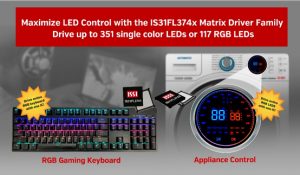
“The growth in video gaming peripherals requires ever more customizable RGB LEDs synchronized to the gaming environment,” said Ven Shan, ISSI VP of Analog products. “ISSI’s latest family of matrix FxLED drivers provides peripheral designers with a feature rich, fast and flexible control of a large number LEDs; simplifying the integration and synchronization of the LED lighting effects for the high end gaming platforms.”
The signals required to support 351, or 180 LEDs are driven in a row/column multiplexed architecture which reduces device package size while resulting in fewer traces and minimal PCB area. The added advantage of driving LEDs in this row/column configuration is that no LED will ever be reverse-biased at any time thereby improving LED longevity. For applications requiring a huge array of LEDs, up to 4 IS31FL374x devices can be connected with one I2C bus.
Key features and benefits of the IS31FL3741, IS31FL3742:
- High LED Count – Up to 351 LEDs (39×9) matrix
- 1/9 Duty Cycle Scanning – Higher average LED brightness
- Theatrical Dimming – Three selectable smooth dimming scenarios for each LED
- De-Ghost Function – Guarantees LED is either fully ON or OFF
- Global Current Set – 256 steps Global Current Setting
- 8-bit Dot Correction – Individual 256 DC peak current control steps
- 8-bit Grayscale Control – Individual 256 PWM control steps
- Fault Detection – Individual LED open or short detection with system notification
- High Speed Interface – 1MHz I2C-compatible interface provides fast access to LED registers
- Industrial Temperature – Operating temperature range -40°C to +125°C for high reliability
Please contact Allyanz today for further details and support on ISSI’s range of LED drivers, including samples & evaluation boards.